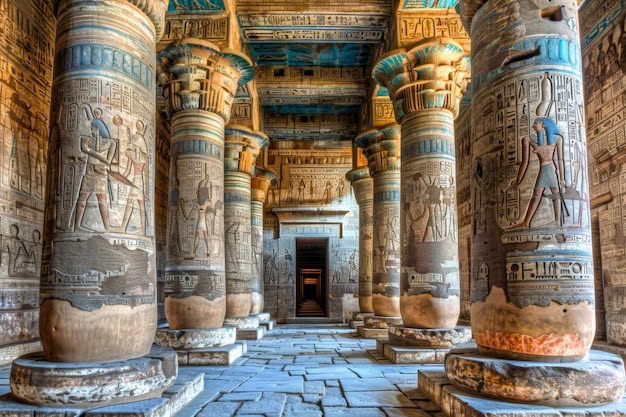Ancient Egyptian architecture remains one of the most extraordinary achievements in human history, a remarkable blend of artistry, engineering, and profound spiritual symbolism. These timeless structures—ranging from imposing temples to intricately adorned columns—served not only functional purposes but also stood as profound expressions of the Egyptian people’s unwavering devotion to their gods and their deeply held belief in the afterlife. The grandeur and complexity of these architectural feats continue to captivate and inspire audiences worldwide, offering a glimpse into the advanced understanding and cultural depth of one of history’s most fascinating civilizations.

The Sacred Elements of Egyptian Architecture highlight its unparalleled artistry and spiritual significance. Among these are the ornate columns found within the temples. Far from being mere structural supports, these columns were masterpieces in their own right. Their capitals, often shaped like the heads of Hathor or the blossoming papyrus plant, conveyed layers of symbolism connected to fertility, life, and divine power. Every inch of their surfaces was meticulously adorned with carvings that depicted gods, sacred emblems, and motifs rich with religious meaning. This intricate artistry was not solely decorative; it served as a medium to communicate the Egyptians’ reverence for their gods, their worldview, and their role in the universe.
In addition to their architectural splendor, the walls of temples and tombs were inscribed with hieroglyphic carvings that served dual purposes: they chronicled historical events and acted as spiritual instruments. These hieroglyphs were much more than artistic flourishes; they were seen as sacred tools to bridge the earthly realm with the divine. Every carved symbol carried spiritual weight, often intended to preserve prayers, rituals, and narratives for eternity. By capturing the essence of their beliefs and recording their histories, the Egyptians ensured that their legacy would remain imperishable, etched into the stones of their monumental structures.
Another stunning feature of Egyptian temples was their ceilings, often adorned with celestial representations that reflected the people’s deep fascination with the cosmos. These astronomical designs were not merely decorative but symbolized the eternal cycle of life, death, and rebirth—a central theme in Egyptian spirituality. Looking up at these ornate ceilings, one would witness depictions of constellations, stars, and other celestial elements, embodying the connection between the heavens and the divine. This fusion of art and astronomy highlighted the Egyptians’ sophisticated understanding of the universe and their belief in life as an eternal journey.
Moving beyond their symbolic significance, the engineering achievements of ancient Egypt are no less awe-inspiring. The massive Hypostyle Hall at Karnak Temple serves as a prime example of their unparalleled architectural expertise. This hall, with its towering columns arranged in rows that seem to stretch endlessly toward the sky, reflects the Egyptians’ ability to conceptualize and construct on a monumental scale. The sheer size and precision of these columns demonstrate not only their engineering prowess but also the immense power and resources wielded by the pharaohs who commissioned these works. Each column, meticulously designed and carved, stands as a testament to the ambition and skill of ancient Egyptian builders.
The legacy of ancient Egyptian architecture extends far beyond its historical context, leaving an indelible mark on civilizations throughout history. The influence of their architectural techniques and symbolic artistry can be seen in structures built centuries later, as architects and engineers drew inspiration from the grandeur of Egypt’s monumental works. Even today, these ancient creations continue to evoke wonder and admiration. Tourists from around the globe travel to see the temples of Luxor, the pyramids of Giza, and other iconic structures, marveling at their scale, detail, and ingenuity. These monuments not only preserve the legacy of ancient Egypt but also serve as a reminder of humanity’s ability to achieve greatness through creativity, dedication, and vision.
Beyond their historical and cultural significance, these architectural marvels also reveal much about the society that created them. Ancient Egypt was a civilization deeply attuned to the rhythms of nature and the cosmos, with an unwavering belief in the afterlife. Their architecture reflects these values, with every structure meticulously designed to align with cosmic and natural principles. Temples were often oriented to capture the rising sun, symbolizing creation and renewal, while tombs were constructed to guide the deceased toward the afterlife. The integration of these spiritual beliefs into their architectural designs showcases the Egyptians’ ability to merge functionality with profound meaning.
The enduring appeal of ancient Egyptian architecture lies in its ability to transcend time, continuing to inspire and educate generations thousands of years after its creation. It is a testament to the creativity, determination, and spiritual depth of a civilization that sought to leave an everlasting mark on the world. These structures are more than historical artifacts; they are a celebration of human potential and a reminder of the power of art, engineering, and belief to shape and define a culture.
In conclusion, the magnificence of ancient Egyptian architecture stands as a remarkable achievement in the annals of human history. Its blend of artistic excellence, engineering innovation, and spiritual depth continues to captivate the modern imagination. From the ornately carved columns and hieroglyphic inscriptions to the celestial ceilings and monumental halls, every element of Egyptian architecture reflects a profound connection to the divine and a legacy of unparalleled ingenuity. These ancient structures remain a source of inspiration, offering valuable lessons about creativity, faith, and the enduring human spirit. Whether viewed as historical wonders or as symbols of humanity’s boundless potential, the architectural achievements of ancient Egypt are truly timeless, deserving of both admiration and reverence.





